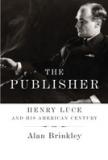A Successful Life-Time
We live in the twilight of the age of mass print media. Publishing dinosaurs are sliding into the tar pits of pre-history, and the underbrush Twitters with quick new life forms evolving in unknowable directions at breakneck speed.
As much as anyone, Henry Robinson Luce, co-founder and absolute mogul of the Time-Life empire, defined the print media model that dominated for most of the last century. Alan Brinkley, a National Book Award winner and a historian of American popular culture, has produced a crisp and judicious biography of Luce and a fine history of a great publishing enterprise. Even better, he gives us a nuanced portrayal of an evolving American sensibility through the lens of masters of mass media.
Luce is probably best remembered for the 30 years or so when he sat at the very pinnacle of publishing—ruler of Time, Life, Fortune, film, book publishing and much else. He was a shaper of opinion, the sought-after advocate, the feared antagonist. In fact, although Brinkley’s account is smooth and efficient, those years comprise the least interesting part of the book. The stories are too well known—the decision to enter World War II, coming to grips with the reality of Soviet Communism, Luce’s irrational devotion to Chiang Kai-Shek, his fascination with a “national purpose”—and Luce was never as influential as he was thought to be. In the march of events, he was an important part of the orchestra, but never the conductor.
It is the earlier years that are fascinating. Born in China in 1898, Luce was the eldest son of impecunious but modestly well-connected Chinese missionaries. A scholarship boy at Hotchkiss and Yale, he was possessed of fierce, almost frightening, ambition and determination. Luce methodically laid out his Yale career to earn, as he wrote to his parents, the maximum “prestige and a chance for influence.” Despite onerous scholarship-related work duties, Luce plunged maniacally into extracurricular activities, earned outstanding grades and rushed at a top fraternity. He graduated from Yale one of a handful of Very Big Men on campus, more or less exactly as he had intended.
One lasting school friendship was with Brit Hadden, who competed as fiercely as Luce at every stage, usually ending just a nose ahead. Luce may have been the more intellectually gifted, but he had none of the natural charisma and easy affability that gave Hadden his edge.
After a couple of years of bouncing from job to job, the two ended up together as cub reporters in Baltimore, where they conceived of a weekly “paper” tentatively entitled Facts, eventually born as Time. It was mostly Hadden’s idea, but Luce’s drive and focus made it happen.
“Facts,” Luce wrote, “will contain all the news on every sphere of human interest, and the news organized.” No article would be more than 200 words long, and the placement and sequence of topics would be exactly the same in every issue. The target audience was “the illiterate upper classes, the busy business man, the tired debutante, to prepare them at least once a week for a table conversation.”
The founding of Time is a thrilling tale, and Brinkley tells it well. For months, the two spent all their free time experimenting with layouts, composing news briefs, searching for the easy, slightly flip style—again, mostly Hadden. They quit their jobs, frantically raised less money than they had hoped and launched the first issue in February 1923, just weeks before Luce’s 25th birthday.
Miraculously, after months hanging on the financial precipice, Time pulled through. Circulation grew; they raised more money, even paid themselves salaries. Luce got married to a Chicago socialite, Lila Hotz, winning over a very skeptical father. But success was hard on Hadden. He became increasingly erratic, depressed and alcoholic and died quite suddenly of streptococcus in 1929. By then Time was minting money—and continued to do so through the Depression. By his mid-30s Luce was a publishing titan.
Astonishingly, except for tweaks like the addition of color, Time was exactly the magazine that he and Hadden had mocked up in their late-night brainstrom sessions—they had been right from the start.
Life was a similar story. Luce conceived it himself, put together a design team, pushed them until he was happy with the result and, along the way, plowed much new ground in the mass printing and production of quality photography. It wobbled a bit when first out of the blocks, just as Time had, then caught the country’s imagination and took off like a rocket—once again, in exactly the form Luce had conceived.
Luce was a publishing genius but a difficult, demanding, unsettled person. Brinkley tells us all we need to know about the breakup of his first marriage, his few serious affairs and how he and Clare Booth drove each other crazy.
But the real story is Luce the publisher, the invention of new media and how the publishing empire and America reflected and defined each other. Altogether it is a fascinating tale, masterfully told.
This article also appeared in print, under the headline “A Successful Life-Time,” in the July 19, 2010, issue.








